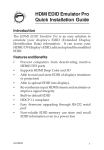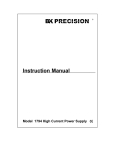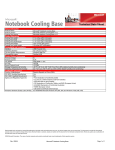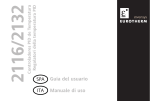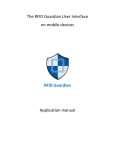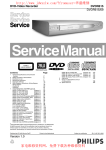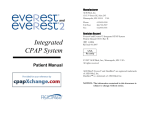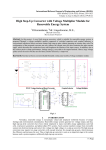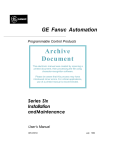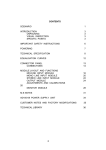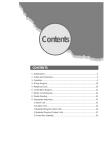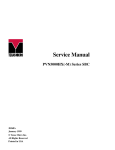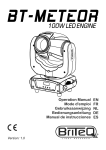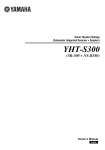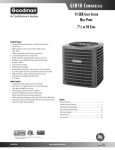Download C:\Documents and Settings\greg\
Transcript
BK PRECISION Instruction Manual Model 1796 High Current Power Supply Limited Two Year Warranty B & K Precision Corp. warrants to the original purchaser that its product and the component parts therof, will be free from defects in workmanship and materials for a period of two years from the data of purchase. B & K Precision Corp. will, without charge, repair or replace, at its' option, defective product or component parts. Returned product must be accompanied by proof of the purchase date in the form a sales receipt. To obtain warranty coverage in the U.S.A., this product must be registered by completing and mailing the enclosed warranty card to B & K Precision Corp. 22820 Savi Ranch Parkway Yorba Linda, CA-92887, within fifteen (15) days from proof of purchase. Exclusions: This warranty does not apply in the event of misuse or abuse of the product or as a result of unanthorized alternations or repairs. It is void if the serial number is alternated, fefaced or removed. B & K Precision Corp. shall not be liable for any consequential damages, including without limitation damages resulting from loss of use. Some states do not allow limitation of incidental or consequential damages, so the above limitation or execlusion may not apply to you. This warranty gives you specific right and you may have other rights, which vary from state-to-state. Model Number: ______________ Date Purchased: __________ TABLE OF CONTENTS SECTION PARTICULARS PAGE NO. 1 GENERAL INFORMATION 1 2 SPECIFICATIONS 2 3 INSTALLATION 3 4 OPERATING INSTRUCTIONS 5 5 SERVICE INSTRUCTION 10 6 PART LIST 16 7 SCHEMATICS 22 8 CIRCUIT DIAGRAMS 26 SECTION - 1 GENERAL INFORMATION 1.1 DESCRIPTION : The 1796 High Current Regulated D.C. Power Supply is completely solid and suitable for bench operation or standard 19" rack operation. It is a well regulated constant voltage / constant current supply which delivers 0 - 16V at 0 - 50Amps and can be adjusted continuously throughout the output range. When the supply is used as a constant voltage source the front panel VOLTAGE controls can be used to limit the output voltage. When the unit is used as a constant current source, the front panel CURRENT controls can be used to limit the output current. The unit will automatically cross over from constant voltage to current mode and vice-versa if the output current or voltage exceeds these limits. Output voltage and current are continuously monitored on two front panel meters. The load terminals and remote sense terminals are provided on the front panel. Either the positive or negative output terminal may be grounded or the power supply can be operated floating at upto a maximum of ±300VDC above ground. 1.2 OUTPUT ON/OFF SWITCH : The output voltage and Current can be preset without connecting the power supply to the load. With the OUTPUT ON/OFF switch in the OFF position, the maximum voltage and current limits can be set. Pressing the OUTPUT ON switch connects the output of the power supply to the load. 1.3 LIMIT SETTING : The voltage and current limits can be set when the output is not connected to the load. With the OUTPUT ON/OFF switch in the OFF position and the LIMIT switch pressed, the voltage and current limits can be set with the front panel VOLTAGE and CURRENT potentiometers. 1.4 REMOTE PROGRAMMING : The output voltage of the unit can be programmed between 0 to 16V by means of an external remote programming voltage resistor. An external resistance programming selector link is provided on the rear panel for this purpose. 1.5 REMOTE SENSING : The degradation in regulation which occurs at the load due to voltage drop in the load leads can be eliminated by using the power supply in the remote sensing mode operation. The remote sensing mode is selected by a push switch on the front panel. 1 SECTION - 2 SPECIFICATIONS OUTPUT VOLTAGE : LOAD CURRENT : CONSTANT VOLTAGE MODE REGULATION LINE : LOAD : RIPPLE & NOISE : CONSTANT CURRENT MODE REGULATION LINE : LOAD : RIPPLE & NOISE : OVERLOAD PROTECTION TRANSIENT RESPONSE : : Automatic overload and short circuit protection. 100µsecs to within 10mV of set output voltage for load change from 10% to 90%. : : ± 0.2% ± 10mV in constant voltage mode. ± 0.5% ± 10mA in constant current mode. STABILITY : Total drift within 8 hours,after warm up under constant line, load & temp. PANEL METERS : MODE INDICATION : SET LIMIT/ ON-OFF CONTROLS OUTPUT CONTROLS : EXTERNAL PROGRAMMING : OPERATING TEMPERATURE INPUT VOLTAGE DIMENSIONS WEIGHT : : : : : 0-16V DC continuously variable with coarse and fine voltage controls. 0-50 Amp max., continuously variable with coarse and fine controls. Less than ± 0.01% ± 2mV for ±10% change in line voltage. Less than ± 0.01% ± 2mV for load change from zero to full load. Less than 1mV rms max.(20 Hz - 20 MHz) Less than ± 0.05% ±10mA for ±10% change in line voltage. Less than ±0.05% ±10mA for change in output voltage from 0 volts to maximum output voltage. Less than 3mA rms. Digital panel meters(marked V for voltmeter and A for ammeter) are provided with an accuracy of ± 3 counts. Respective LED lights up when the unit is working in CV or CC mode. Push Switches for Limit ( V & A ) and output ON/OFF setting. Single turn coarse and fine voltage and current controls are provided on the front panel Output voltage can be programmed by a variable resistance of 10K 0-40°C. 120/230V AC, ± 10% 47 - 63Hz single phase. 19"(W ) x 15.75"(D) x 5.24"(H). 50 lbs. Net. 2 SECTION - 3 INSTALLATION 3.1 INITIAL INSPECTION : As soon as the power supply 1796 unit is unpacked, inspect for any damage that may have occurred during transit. Save all packing material until inspection is completed. If any damage is found, notify the carriers immediately. Our authorised representatives should also be notified. 3.2 PHYSICAL CHECK : This check should confirm that there are no broken knobs or connectors, that the cabinet and panel surfaces are free of dents and scratches and the meters are not scratched and cracked. 3.3 ELECTRICAL CHECK : The power supply unit 1796 should be checked against electrical specifications. An in-cabinet performance check will verify proper operation. 3.4 INSTALLATION DATA : The power supply unit 1796 is shipped ready for bench operation. It is necessary only to connect the unit to a rated source of power (120V AC) and it is ready for operation. 3.5 LOCATION : The power supply 1796 unit is fan cooled. Sufficient space should be kept around the unit while in operation, so that unit do not remain in confined space or close to another heating source.The ambient temperature of the area around the unit should be less than 40°C. 3.6 RACK MOUNTING : The unit is in rack size and can be rack mounted in a conventional rack using standard mounting screws and the rack attachments optionally supplied. 3.7 INPUT POWER REQUIREMENTS : The power supply 1796 unit may be operated continuously from input voltage of 120V or 230V AC 47 - 63Hz power source. It is factory wired for 120V AC operation. 3 3.8 INPUT TAP SELECTION FOR 230V OPERATION : In case of 230V operation please ensure the shorting links on the Tap Selection boards are changed to 230V marked on the PCB for both Mains Transformer & Auxulary Transformer as per the following diagram. TAP SELECTOR BOARD Please make sure the input varistor is replaced by 20D 361K or equivalent for 230V Mains Operation at the Input of EMI Filter located at bottom side of the unit. 3.9 REPACKAGING FOR SHIPMENT : To ensure safe shipment of the power supply 1796 unit, it is recommended that the package designed for the unit be used. The original packaging material is reusable. Be sure to attach a tag to the unit specifying the owner, and the fault observed with a brief description. 4 SECTION - 4 OPERATING INSTRUCTIONS 4.1 TURN ON SETTING PROCEDURE : The following procedure describes the use of controls and indicators for Constant Voltage and Constant Current Mode of Operation. CONSTANT VOLTAGE (CV) MODE : a. Set ‘POWER ON’ Switch & keep the OUTPUT ON/OFF switch to OFF position ( ). b. Press LIMIT switch and adjust the VOLTAGE controls till the desired voltage is indicated on Voltmeter ( ). c. Press OUTPUT switch to ON position and observe that CV LED lights ( ) CONSTANT CURRENT VOLTAGE (CC) MODE : a. Turn off the suppy. Short circuit the output terminals of the power supply & turn on the supply. b. Keep the OUTPUT ON/OFF switch in the OFF position ( ). c. Press LIMIT switch and adjust the CURRENT controls till the desired current is indicated on Ammeter ( ). d. Press OUTPUT switch ON position and observe that CC LED lights ( ). e. Remove the short circuit. 4.2 SET LIMIT CONTROL (VOLTAGE AND CURRENT) : To preset the output Voltage and Current, proceed as follows : a. Set the OUTPUT switch to OFF position ( ) ( Release Position ). b. Press the LIMIT switch and adjust the desired output voltage with the VOLTAGE control potentiometers ( ). c. Release the LIMIT switch, set the OUTPUT switch to ON position and check the output voltage on the voltmeter ( ). d. Set the OUTPUT switch to OFF position ( ). e. Press the LIMIT switch and adjust the desired output current limit with the CURRENT control potentiometers ( ). f. Release the LIMIT switch, set the OUTPUT switch to ON position and check the output current on the ammeter ( ). g. Set the OUTPUT switch to OFF position ( ). h. Connect the load to the Output terminals and set the OUTPUT switch to ON position ( ). 4.3 LOAD CONNECTIONS : The load should be connected to the power supply output terminals using separate pairs of connecting wires. This will minimize mutual coupling effects between loads and will retain full advantage of the low output impedance of the power supply. Each pair of connecting wires should be as short as possible and twisted or shielded to reduce noise pick up. (If a shielded pair is used, connect one end of the shield to ground and leave the other end unconnected). 5 4.4 If load considerations require that the output power distribution terminals be remotely located from the power supply ,then the power supply output terminals should be connected to the remote distribution terminals via a pair of shielded or twisted wires and each load should be separately connected to remote distribution terminals. 4.5 Positive or negative voltage can be obtained from this supply by grounding either one of the output terminals or one end of the load. Always use two leads to connect load to the supply, regardless of where the setup is grounded. This will eliminate any possibility of the output current return paths through the power source ground which would damage the line cord plug. This supply can also be operated upto ±300V DC above ground, if neither output terminal is grounded. 4.6 REMOTE SENSING : Warning : Do not Operate the Unit in'REMOTE SENSE' mode without en suring proper 'REMOTE / 4 TERMINAL' Connections. Serious Damage to Unit or Equipment under test could result. Remote sensing is used to maintain good regulation at the load and reduce the degradation of regulation which could occur due to the voltage drop in the leads betweeen the power supply and the load. Remote sensing is accomplished by connnecting the load to remote sense terminals on the front panel. The leads from the sensing( +S and -S) terminals to the load will carry much less current than the load leads and it is not required that these leads be as heavy as the load leads. However, they must be twisted or shielded to minimize noise pickup. For reasonable lengths of load leads, remote sensing greatly improves the performance of the supply. However, if the load is located at a considerable distance from the supply, added precautions must be observed to obtain satisfactory operation. Notice that the voltage in the load leads subtracts directly from the available output voltage and also reduces the amplitude of the feedback error signals that are developed within the unit. Because of these factors, it is recommended that the drop in each load lead does not exceed 0.5Volts. NOTE : Due to the voltage drop in load leads, it may be necessary to readjust the current limit in the remote sensing mode. Observance of the precautions in para. 4.8 and 4.9 will result in a low dc output impedance at the load. However, another factor that must be considered is the inductance of long leads.This causes a high ac impedance and could affect the stability of the feed back loop seriously enough to cause oscillations. If this is the case, it is recommended that the following actions be taken : a) Adjust R145 to remove oscillations, or to achieve best possible transient response for given long load lead configuration. 6 b) If performing adjustment in step (a) above does not remove oscillation, disconnect output capacitor C2(L1791-FP-CNT-1203 PCB) and connect a capacitor having similar characteristics ( approximately the same capacitance, the same voltage rating or greater, and having good high frequency characteristics) directly across load using short leads. Readjust R145 as in step (a) above after making this change. 4.7 OUTPUT CAPACITANCE : Internal capacitor C2 (L1791-FP-CNT-1203 PCB) connected across the output terminals of the power supply, helps to supply high current pulses of short duration during constant voltage operation. Any capacitance added externally will improve the pulse current capability, but will decrease the safety provided by the constant current circuit. A high current pulse may damage load components before the average output current is large enough to cause the constant current circuit to operate. The effects of the output capacitor during constant current operation are as follows: a. The output impedance of the power supply decreases with increasing frequency b. The recovery time of the output voltage is longer for load resistance changes. c. A large surge current causing a high power dissipation in the load occurs when the load resistance is reduced rapidly. 4.8 REVERSE VOLTAGE LOADING : A diode CR1 is connected across the output terminals. Under normal operation, the diode is reverse biased (anode connected to the negative terminal ). If a reverse voltage is applied to the output terminals ( positive voltage applied to the negative terminal), the diode will conduct, shunting current across the output terminals to the forward voltage drop of the diode. This diode protects the series transistor and the output electrolytic capacitors. 4.9 REVERSE CURRENT LOADING : Active loads connected to the power supply may actually deliver a reverse current to the power supply during a portion of its operating cycle. An external source cannot be allowed to pump current into the supply without loss of regulation and possible damage to the output capacitor. To avoid these effects, it is necessary to preload the supply with a dummy load resistor so that the power supply delivers current through the entire operation cycle of the load device. 4.10 EXTERNAL PROGRAMMING : Remote external programming can be achieved changing the external program link on rear panel and connecting a variable resistor of 10K across the terminals as shown on the rear panel. 7 OPERATORS SAFETY SUMMARY The general safety information in this part of the summary is for both operating & servicing personnel. Specific warnings and cautions will be found throughout the manual where they apply, but may not appear in this summary. TERMS IN THIS MANUAL : CAUTION : Statements identify conditions or practices that could result in damage to the equipment or other property. WARNING : Statements identify conditions or practices that could result in personal injury or loss of life. TERMS AS MARKED ON EQUIPMENT : CAUTION : Indicates a personal injury hazards not immediately accessible as one reads the markings,or a hazard to property, including the equipment itself. DANGER : Indicates a personal injury hazard immediately accessible as one reads the marking. POWER SOURCE : This product is intended to operate from a power source that does not apply more than 130V rms between the suply conductors or between either supply conductor and ground. If the Internal Tap is selected for 230V AC operation, then the input voltage should not be more than 250V rms. A protective ground connections by way of the grounding conductor in the power cord is essential for safe operation. GROUNDING THE PRODUCT : This product is grounded through the grounding conductor of the power cord. To avoid electrical shock, plug the power cord into a properly wired receptacle before connecting to the product input or output terminals. A protective ground connection by way of the grounding conductor in the power cord is essential for safe operation. DANGER ARISING FROM LOSS OF GROUND : Upon loss of the protective ground connection, all accessible conductive parts (including knobs and controls that may appear to be insulating) can render an electric shock. USE THE PROPER POWER CORD : Use only the power cord and connector specified for your product. Use only a power cord that is in good condition. Refer cord and connector changes to qualified service personnel. 8 USE THE PROPER FUSE : To avoid fire hazard, use only fuse of the correct type, voltage rating and current rating as specified in the parts list for your product. For 115V operation 20A, For 230V operation 10A Slow blow. Refer fuse replacement to qualified service personnel. DO NOT OPERATE IN EXPLOSIVE ATMOSPHERES : To avoid explosion, do not operate this instrument in an explosive atmosphere unless it has been specifically certified for such operation. DO NOT OPERATE UNIT WITHOUT COVERS : To avoid personal injury, do not operate this product without covers or panels installed. SERVICING SAFETY SUMMARY FOR QUALIFIED SERVICE PERSONNEL ONLY Refer also to the Operators Safety Summary DO NOT SERVICE ALONE : Do not perform internal service or adjustment of this product unless another person capable of rendering first aid and resuscitation if present. USE CARE WHEN SERVICING WITH POWER ON : Dangerous voltages exist at several points in this product. To avoid personal injury, do not touch exposed connections or components while power is on. Disconnect power before removing protective panels, soldering, or replacing components. POWER SOURCE : This product is intended to operate from a power source that does not apply more than 130V rms between the supply conductors or between either supply conductor and ground. A protective ground connection by way of the grounding connector in the power cord is essential for safe operation. 9 SECTION - 5 SERVICE INSTRUCTION 5.1 GENERAL : The instrument has been tested throughly and then released for dispatch. Normally, the unit works satisfactorily under all condition. However due to ageing / misuse or malfunctioning, the unit may become defective. In case, the user wants to carryout Servicing, the following instructions will be helpful in rectifying the defects The Servicing shall be done only by Qualified personnel. 5.2 TROUBLE SHOOTING TECHNIQUES : 5.2.1 INTRODUCTION : The trouble shooting procedure is arranged in an order that checks the simple trouble possibilities before proceeding to extensive troubleshooting. Incorrect control settings can seem like a trouble that 5.2.2 CONTROL SETTINGS : does not actually exist.If there is any question about the correct function or operation of any control, see the Operating Instructions section. 5.2.3 SYSTEM AND ASSOCIATED EQUIPMENT : Before trobleshooting the 1791 (350) check for proper input fuse as per part list is intac. Check the line voltage at the power source before connecting the mains cord is rated for the correct input voltage. Verify that the front panel controls are kept at minimum position. The output terminals must be free from any load connecting leads. 5.2.4 VISUAL CHECK :Many troubles can be located by visual clues such as unsoldered connections, broken wires, damaged circuit board, damaged components, etc. 5.2.5 INTERNAL ADJUSTMENT : Check the Adjustment of the suspected circuit if the trouble is obviously in a certain circuit. The trouble may only be a result of misadjustment and may be corrected by readjustment. 5.2.6 CIRCUIT ISOLATION : Note the trouble symptoms. These often identify the circuit in which the trouble is located. When trouble symptoms appear in more than one circuit,check the effected circuits by making waveform and voltage measurements. 5.2.7 COMPONENT CHECKING : If a component cannot be disconnected from its circuits, then the effects of the associated circuitry must be considered when evaluating the measurement. Except for soldered-in transistors and integrated circuits, most components can be lifted at one end from the circuit board. 5.2.8 TRANSISTORS AND IC's : Turn the power switch off before removing or replacing any semiconductor. A good check of transistor operation is actual performance under operating conditions. A transistor can most effectively be 10 checked by substituting a new component for it ( or one which has been checked previously). However, be sure that circuit conditions are not such that a replacement transistor might also be damaged. If substitute transistors are not available, use a dynamic tester. Static-type testers are not recommended, since they do not check operation under simulated operating conditions. An approved anti-static suction-type desoldering tool must be used to remove soldered-in transistors. Integrated circuits can be checked with a voltmeter, test oscilloscope, or by direct substitution. A good understanding of the theory of operation is essential to troubleshooting circuits using IC's. Operating waveforms, logic levels, and other operating information for the IC's are given in the theory of operation. Use care when checking voltages and waveforms around the IC's so that adjacent leads are not shorted together. A convenient means of clipping a test probe to the 14 pin in-line IC is with an integrated circuit test clip. This device also doubles as an extraction tool. 5.2.9 DIODES : Do not use an ohmmeter that has a high internal current. High currents may damage a diode. A diode may be checked for an open or shorted condition by measuring the resistantce. With an ohmmeter scale having an internal source of between 800mV and 1.5V, the resistance should be very high in one direction and very low when the leads are reversed. 5.2.10 RESISTORS : Check the resistors with an ohmmeter. Resistor tolerances are given in the Electrical Parts List. Resistors do not normally need to be replaced unless the measured value varies widely from the specified value. 5.2.11 CAPACITORS : A leaky or shorted capacitor can be detected by checking resistance with an ohmmeter on the voltage rating of the capacitor. The resistance reading should be high after initial charge of the capacitor. An open capacitor can best be detected with a capacito meter, or by checking whether it passes ac signals. 5.3 REPAIRS & MAINTENANCE : 5.3.1 Remove the mains cord from the source before removing top cover of the unit 5.3.2 To open the cover, remove Screws from Top & Bottom Covers. Disconnect Grounding of the Covers. 5.3.3 If there is no output, check the input supply Voltage and the Fuse continuity, etc. Check Both Fans are working. 5.3.4 If the output is high and unregulated, check for open Voltage adjust potentiometer or shorted mosfet, etc. 5.3.5 Similarly, if the current is unregulated, check for value change in the Shunt Resis tor. It may get open. 11 5.3.6 If Fuse blows, connect the unit through a variable AC Source with a current meter and monitor the current at no load. If the current is very high (more than 2 ampere or so) load, check for Bridge Rectifier short or shorted Diode,or Secondary Winding short, etc 5.3.7 If output voltage or current DPM's are not reading, check for loose connections especially in crimping, soldering of Connectors. WARNING THE FOLLOWING SERVICING INSTRUCTIONS ARE FOR USE BY QUALIFIED PERSONNEL ONLY. TO AVOID PERSONAL INJURY, DO NOT PERFORM ANY SERVICING OTHER THAN THAT CONTAINED IN OPERATING INSTRUCTIONS UNLESS YOU ARE QUALIFIED TO DO SO. REFER TO OPERATORS SAFETY SUMMARY AND SERVICE SAFETY SUMMARY PRIOR TO PERFORMING ANY SERVICE. 5.4 VOLTAGE & WAVEFORM CHECK POINTS : 5.4.1 TEST EQUIPMENTS REQUIRED : Generally, Wide-band Oscilloscope 20MHz Dual Trace, a probe 1:10 150MHz, and a multimeter 4½ DMM, Rheostats, Variable Line Source 20A, Test Leads are all that is needed to perform basic waveform and voltage checks for diagnostic pusposes. CONNECT THE MAINS CORD OF THE UNIT TO THE RATED I/P SOURCE. 5.4.2 Check the voltage & waveforms at test points TP1 to TP6 on PRSR 0896 PCB with respect to output positive or at TP7 with the help of 4½ DMM & CRO. Normal voltages & waveforms are given below :Keep output voltage to max. position with front panel control. All readings are with respect to TP7 as common :Test Points on Voltages on AMP/FREQ. WAVEFORM PRSR PCB DMM Level on CRO on CRO TP1 +12.01V 26.7V P-P / 99.8Hz TP2 +1.03V 2V P-P / 99.8Hz TP3 -12.04V 26.8V P-P / 99.6Hz TP4 -11.35V 25.3V P-P / 99.6Hz TP5 +0.101V 3V -P / 99.6Hz TP6 +15.05V 26.8V P-P / 99.6Hz 12 5.4.3 VOLTAGES AT VARIOUS PINS OF IC LM324 IS AS FOLLOWS ( IC-101 ) :IC PIN NO. VOLTAGES & CHECK CONDITIONS PIN1 -PIN1 -PIN2 & 3-PIN4 -PIN7 -PIN7 -PIN8 -PIN8 -PIN9 -PIN10 -PIN14 -- 0V ( WHEN V POT KEPT AT MIN. POSITION IN CV MODE ) +5V ( WHEN V POT KEPT AT MAX. POSITION IN CV MODE ) +4.9V AT V POT MAX. POSITION. +12V ALL CONDITION 0V AT CC POT MIN. POSITION. 0.5V AT CC POT MAX. POSITION. +1V TO 3.5V IN CV MODE. +10V TO +11V IN CC MODE. 0V. -6mV. +10 TO 11V IN CV MODE. 5.4.4 A. B. C. CHECK VOLTAGES AT CR124 CHECK VOLTAGES AT Z101 CHECK VOLTAGES AT Z102 CATHODE +10V CATHODE +10V CATHODE -4.5V 5.4.5 CHECK ALL REGULATORS OUTPUT WITH RESPECT TO OUTPUT +VE COMMON. REF. PCB NO. PART NO. PIN NO. VOLTAGES VR101 IC7812 3 +12V VR105 IC79L05 3 -5.0V VR106 IC7805 3 +5.0V CHECK WITH RESPECT TO OUTPUT -VE AS COMMON. VR104 IC7812 3 +12.0V All the above readings are approximate values. The given voltages & waveforms are refering to a normal working unit. If find any Voltage or Waveform absent at given points, then trace back to the associated circuits. This complets basic trouble shooting test points. 5.5 PARTS ORDERING & REPLACING : 5.5.1 OBTAINING REPLACEMENT PARTS : Most electrical parts can be obtained through your local distributor or representative. However you should be able to obtain many of the standard components from a local commercial source in 13 your area. Before you purchase check the electrical parts list for the proper value rating, tolerance and description. 5.5.2 ORDERING PROCEDURE : When ordering replacement parts from B+K Inc. please include the following minimum information : 1. Power Supply Type ( 1791 B & K ), Model Code : 350 2. Power Supply Serial Number ( For example, 01040036 ) 3. A description of the part ( if electrical include the circuit number ). 5.5.3 CIRCUIT BOARDS : If a circuit board is damaged beyond repair, the entire assembly including all soldered-on components can be replaced. To remove or replace a board, proceed as follows :1. Disconnect all Sockets & leads connected to the board ( both soldered lead connections and solderless pin connections ). 2. Remove all mounting screws holding the board in the instrument. Rmove any knobs, etc. that would prevent the board from being lifted out of the instrument. 3. Lift the circuit board out of the unit. Do not force or bend the board. 4. To replace the board, reverse the order of removal. Use care when replacing pin connectors. If forced into place incorrectly positioned, the pin connectors may be damaged. 5.5.4 TRANSISTORS AND IC's : Transistors and IC's should not be replaced unless they are actually defective. If removed from their sockets during routing maintenance, return them to their original sockets. Unnecessary replacement or switching of semiconductor devices may affect the calibration of the instruments. When a transistor is replaced, check the operation of the part of the instrument that may be affected. Replacement semiconductors should be of the original type or a direct replacement. When removing soldered-in transistors, use an approved anti-static suction-type desoldering tool to remove the solder from the holes in the circuit board. An extracting tool should be used to remove the 14 pin integrated circuits to prevent damage to the pins. If an extracting the pins. Pull slowly and evenly on both ends of the IC. Avoid having one end of the IC disengage from the socket before the other end. 14 CAUTION Static discharge can damage any semiconductor component in this instrument. This instrument contains electrical components that are susceptible to damage from static discharge. Static voltages of 1KV to 30KV are common in unprotected environments. Observe the following precautions to avoid damage : 1. Minimize handling of static-sensitive components. 2. Transport and store static-sensitive components or assemblies in their original containers, on a metal rail, or on conductive foam. Label any packages that contains static-sensitive assemblies or components. 3. Discharge the static voltages from your body by wearing a wrist strap while handling these components. Servicing static-sensitive assemblies or components should be performed only at a static-free workstation by qualified service personnel. 4. Nothing capable of generating or holding a static charge should be allowed on the work station surface. 5. Keep the component leads shorted together whenever possible. 6. Pick up components by the body, never by the leads. 7. Do not slide the components over any surface. 8. Avoid handling components in areas that have a floor or work-surface covering capable of generating a static charge. 9. Use a soldering iron that is connected to earth ground. 10. Use only special anti-static suction-type or wick-type desoldering tools. 15 6.6 FAULT FINDING PROCEDURE ( A ) FUSE BLOWS FUSE BLOWS Is Line Voltage OK ? N Adjust Proper Line Voltage. N Insert proper rating Fuse. N Adjsut the Tap according to required voltage. Y Is Fuse Rating OK ? Y Is Mains Transformer Tapping OK ? Y Are Power Diodes Connected on Heat Sink Short ? Y Replace the Damaged Diodes. N Is Remote Sense Switch Pressed in Normal Condition ? N Y Release the Remote Switch in Normal Load Condition. Is Device Drop setting proper on Load ? N Turn ON the Unit at Rated input Voltage. Load the Unit at max rated Voltage and Current. Adjust the Voltage between Output Positive and Capacitor Positive between 4.5V to 5V by using Please VR1 on PREG PCB 1. Check Line Voltage for 230V AC or 115V AC, whichever applicable. 2. Check whether Fuse Present is 20A for 115V AC I/P and 10A for 230VAC I/P. 3. Check the Transformer Tapping, whether it is configured accordingly to I/P Line Voltage. 4. The Power Diodes connected in Bridge configuration on Heat sink might be short. 5. If Remote Sense Switch is pressed on Load, in Normal Operation, there is chance unit may take High Current and Fuse might Blow. 6. If Device Drop measured across O/P Positive and Capacitor Positive is not between 4.5V to 5V at rated I/P Voltage and rated O/P Voltage and Load condition, there is a chance of Fuse getting blow in Load Condition. Note : 4.5V to 5V Device Drop at Full Load. 16 ( B ) UNREGULATED O/P VOLTAGE UNREGULATED O/P VOLTAGE N Is IC LM324 OK ? Replace the IC. Y Is Voltage Pot Open OR Pot Wire is Reaching PCB ? N Replace the Voltage Pot and Ensure proper continuity with the PCB N Replace the Damaged Mosfet. Y Are Mosfets OK ? Y Is Gate Wire of Mosfet Reaching PCB ? N Ensure proper continuity of Gate Wire and PCB. Y Are Diodes D3 and D4 on Front Panel PCB OK ? N Replace the Damaged Diode. Y Is INT & COM Terminal on Back Panel Short ? N Short INT COM Terminal when External Programming is not in use. 1. Check IC LM324 on Front Panel PCB (L1791-FP-CNT1203). It might be damaged. 2. Check Voltage Potentiometer (5K Pot), whether it is open or whether the wires associated with Voltage Potentiometer is reaching the Front Panel PCB. 3. Check the Mosfets and Zener Diodes across Mosfet. It might be Short. 4. Check Diodes D3 and D4 on Front Panel PCB. It might be Leaky or Short. 5. Ensure proper continuity of Gate Wire on Front Panel PCB and Mosfet module. 6. Ensure INT and COM Terminal at Back Panel are short when External Programming is not in use. 17 ( C ) NO OUTPUT VOLTAGE. NO O/P VOLTAGE N Is IC LM324 OK ? Replace It. Y Y Is Voltage Pot Short ? Replace It. N Is Voltage Selection Preset Open ? Y Replace It. N Are Zener Diodes Z1 & Z2, Preset VR1 on Preg. PCB OK ? N Replace It. Y Are all the Auxillary Winding Reaching PCB ? Ensure their proper Connectivity with PCB. N Y Is there proper contact of Load Terminal with Terminal Nuts Inside Unit. 1. Y Ensure proper Connectivity of Load Terminals and Terminal Nut inside. Check IC LM324 on Front Panel PCB L1791-FP-CNT-1203. It might be Damaged. 2. Check the voltage Potentiometer. It might be Short. 3. Check Voltage Selection Preset R22 on Front Panel PCB. It might be Open. 4. Check Preset VR1 on Pre-regulator PCB (PS-PREG-1791-0903A). It might be Open. 5. Check whether Auxillary Transformer Windings are reaching PCB. 6. Check whether there is proper contact between Load Terminals and Terminal Nuts inside the Unit. 18 ( D ) NO DPM INDICATION. NO DPM INDICATION Is Display Completely Blank ? Y N Does Display shows only dot Indication ? Y Is Continuity between IC7805 & DPM OK ? N Ensure proper Continuity. Is Continuity between IC7905 & DPM's OK ? N Ensure proper Continuity. N Ensure proper Continuity. Y Is Continuity between ANGD & DPM's OK ? Y Is DPM IC OK ? N Replace It. 1. If there is no Indication at all ensure that there is proper Continuity between +5V Wire of DPM's and IC7805. It might be possible that +5V Wire Crimping might be loose or IC7805 might be Damaged. 2. It DPM shows only a Dot Indication. Check whether -5V from IC 7905 is reaching DPM's. It might be possible that -5V Wire Crimping might be loose or IC 7905 might be Damaged. 3. If DPM shows Dot Indication, check whether AGND ( Grey Wire ) is reaching DPM's. 4. If DPM shows Dot Indication, check DPM IC7107. It might be Damaged. 19 ( E ) DPM NOT READ ( 000 ). DPM NOT READ ( V & I ) ( 000 ) Is DPM IC 707 OK ? N Replace It. N Ensure proper Continuity. N Replace It. Y Does Hi and Low Wire Reach DPM's ? Y IC TL431 OK ? Y Is minimum Resistance of Pot High ? Y Replace Pot. 1. Check whether Voltage Hi and Voltage Low Wire is reaching DPM. 2. Check DPM IC 7107. It might be Damaged. 3. Check minimum Output Voltage of Potemtiometer. It should be less than 150mV. 4. See that Power Supply is earthed properly. 5. Check IC TL 431 ( Z1 and Z2 ) on Front Panel PCB. It might be Damaged. 6. If Current DPM does not read then, check whether Current Hi and Low Wire is reaching Current DPM. 20 ( F ) UNIT NOT TAKE CURRENT. UNIT NOT TAKE CURRENT Is Current Set Preset R21 OK ? N Replace It. Y Y Is Current Pot Short ? Replace It. N N Is Wiring Related to Current Pot OK ? Ensure proper Continuity. Y Are Load Terminals connected properly with Nut inside Unit ? N Ensure proper Terminal Contact. 1. Check Current set Preset R21. It might be open. 2. No Contact of Load Terminals with the Terminal Nut inside the Unit. 3. Current Pot might be Shorted. 6. Check Wiring related to Current Pot. 21 ( G ) UNIT DIRECTLY GOES TO CC. UNIT DIRECTLY GOES TO CC Is Shunt Resistor open OR Dry Soldered ? Y Replace Shunt Resistor if necessary. N N Is IC LM324 OK ? Replace It. Y Y Is Current select Preset R21 Open ? Replace It. N Is Remote Sense Terminal Pressed ? Y Ensure Remote Sense Switch is Unpressed in Normal Condition. 1. Check the Shunt Resistor ( 0.025E / 25E ). It might be Open or Dry Soldered. 2. Check IC LM 324. It might be Damaged. 3. Current select Preset R21 might be Open. 6. Remote Sense Terminal might be Pressed on No Load. 22 ( H ) NO CURRENT CONTROL. NO CURRENT CONTROL Y Is Current Pot Open ? Replace it. N Are Wires related to Current Pot OK ? Y Ensure proper Connectivity. 1. Check the Current Potentiometer. It might be Open. 2. Check all Wires related to Current Potentiometer. (I) POOR LINE REGULATION. POOR LINE REGULATION Improper Device Drop Setting. N Leaky Summing Capacitor C4. Y Y Keep the Input Supply at rated I/P. Keep the O/P Supply at rated Vtg. and rated Load. Measure Vtg. across O/P +Ve and Capacitor +Ve Adjust that Vtg. between 4.5V to 5V with Preset VR1 ( 5K ) on PREG PCB. Replace It. 1. Check whether Device Drop is between 4.5V to 5V. It might not be proper. 2. Leaky Summing Capacitor C4 on PREG PCB. 23 ( J ) POOR LOAD REGULATION. POOR LOAD REGULATION Load Terminal Nut inside Unit might be Loose. N Is there any Oscillation in CV Mode ? Y N Reduce Resistor R6 ( 2.2K ) on F/Panel PCB until Oscillation dies OUT. If Oscillation still Prevail reduce R9 to 2K on F/Panel PCB. Is Capacitor C4 and C2 Leaky ? Y Replace It. 1. Load Terminal might be Loose. Ensure Terminals are tightened properly with Terminal Nuts inside the Unit. 2. There might be Oscillation at Output in CV Mode. Adjust Resistor R6 & R9 until Oscillations die out. 3. Check Capcitor C4 and C2 on PREG PCB. It might be Leaky. ( K ) CV, CC, LED NOT GLOW. 1. Check the LED's. it might be Leaky, Open or Short. 24 ( L ) EXTERNAL PROGRAMMING NOT OK. EXTERNAL PROGRAMMING NOT OK Is Pot connected across INT & COM OK ? Y N Ensure 5K Pot connected between INT and COM Terminal. Is there proper Continuity between PROG Terminal and O/P +Ve ? N Ensure proper Connectivity. 1. Check whether 5K Pot is connected between INT and COM Terminal. 2. Check whether there is proper Continuity between PROG Terminal and Output Positive. (M ) REMOTE SENSE NOT OK. 1. Check whether there are Oscillations at Output, when Remote Sense Switch is pressed. If Oscillations are present reduce Resistor R6 and R9 on Front Panel PCB, until Oscillations die out. 25 1. SECTION - 7 PART LIST & SCHEMATICS L1791-FP-CNT-1203 PCB ASSY Reference Designator RESISTORS R1 R2 R3 R4* R5 R6 R7* R8 R9 R10 R11 R12 R13 R14 R15 R16 R17 R18* R19 R20 R21 ZENERS Z1 DIODES D1 D2 D3 CAPACITORS C1 C2 C3 C4 IC U1 SWITCHES SW1-3 TERMINALS T1 T2 T3 T4 T5 Part Description Reference Part DesignationDescription 1K Not Used 100E 3K 1K 1K1 4K7 6K8 6K8 15K 1K 1K 3.3K, 2W 1K 1K 3.3E 100E 1K1 2K 3K6 500E(3206F) R22 R23 R24 R25 R26 R27 R28 R29 R30* R31* R32 R33 R34 R35 R36 R37 R38 R39 R40 R41 500E(3206F) 16K 10K 10K 100E(3206F) Not Used 100E(3206F) 1K 360E 360E 100E(3206F) Not Used 100K Short 1.5K Short 330K 100E 1K8 12K TL 431 Z2 TL 431 1N4148 1N4148 1N4148 D4 D5 D6 1N4148 1N4007 1N4007 1KPF/100V, DISC 1µF/100V, ELE 220µF/50V, ELE 1KPF/100V, DISC C5 C6 C7 C8 10µF/35V, ELE 10µF/35V, ELE Not Used 0.1µF/230V LM324 ( National ) 2P2W SW PUSH BUTTON 60A / 1000V O/P +Ve RED TERMINAL ( 4mm ) 60A / 1000V O/P -Ve LIGHT BLUE TERMINAL ( 4mm ) 10A / 1000V Sns +Ve RED / BANANA TERMINAL (25mm L) 10A / 1000V Sns -Ve BLACK / BANANA TERMINAL(25mm L) EARTH BRASS BINDING NICKEL PLATED ( 4mm ) 26 1. L1791-FP-CNT-1203 PCB ASSY Reference Designator CONNECTORS J1 J1 CLAMPS SW1 SW2 SW3 SWITCHES SW1 SW2 SW3 2. Part Description Reference Part DesignationDescription J2.54 - 3MSL, 3 PIN SIL 2.54mm ST LOCK MALE J2.54 - 3FSL, 3 PIN SIL 2.54mm ST LOCK FEMALE SINGLE PUSH SWITCH MTG. CLAMP DOUBLE PUSH SWITCH MTG. CLAMP DOUBLE PUSH SWITCH MTG. CLAMP GREY COLOUR CAP FOR PUSH SWITCH GREY COLOUR CAP FOR PUSH SWITCH GREY COLOUR CAP FOR PUSH SWITCH PS-PREG-1791-0903A PCB ASSLY Reference Designator RESISTORS R1 R2 R3 R4 R5 R6 R7 R8 R9 R10 R11 R12 R13 R14 CAPACITOR C1 C2 C3 C4 DIODES D1-22 CONNECTORS J1 J1 J2 J2 J3 J3 Part Description Reference Designation Part Description 3K3, 2W, MOR 270E, 2W, MOR 324E, 0.25W, 5% MFR 180K, 0.25W, 5% MFR 10K, 0.25W, 5% MFR 180K, 0.25W, 5% MFR 8K2, 0.25W, 5% MFR 150K, 0.25W, 5% MFR 82K, 0.25W, 5% MFR 4K7, 0.25W, 5% MFR 820E, 0.25W, 5% MFR 6K8, 0.25W, 5% MFR 12K, 0.25W, 5% MFR 10K, 0.25W, 5% MFR R15 R16 R17 R18 R19 R20 R21 R22 R23 R24 R25 R26 R27 100K, 0.25W, 5%, MFR 22K, 0.25W, 5%, MFR 10K, 0.25W, 5%, MFR 10K, 0.25W, 5%, MFR 3K9, 0.25W, 5%, MFR 390E, 0.25W, 5%, MFR 1K5, 0.25W, 5%, MFR 4.7E, 0.25W, 5%, MFR 3K9, 0.25W, 5%, MFR 15E, 0.25W, 5%, MFR 10E, 0.25W, 5%, MFR 10E, 0.25W, 5%, MFR 270E, 2W, MOR 33µF, 50V ELE 4.7µF, 50V ELE 2.2µF, 50V ELE 1µF, 63V ELE C5 C6 C7 0.1µF, 63V 470µF, 50V, ELE 0.1µF, 230V AC 1N4007 ( 200V / 1A ) J2.54-6MSL, 6 PIN SIL 2.54mm LOCK MALE J2.54-6MSL, 6 PIN SIL 2.54mm LOCK FEMALE J2.54-4MSL, 4 PIN SIL 2.54mm LOCK MALE J2.54-4MSL, 4 PIN SIL 2.54mm LOCK FEMALE J2.54-5MSL, 5 PIN SIL 2.54mm LOCK MALE J2.54-5MSL, 5 PIN SIL 2.54mm LOCK FEMALE 27 2. PS-PREG-1791-0903A PCB ASSLY Reference Designator TRANSISTORS Q1 Q2 Q3 ZENERS Z1 PRESET VR1 TRANSFORMER T1 3. Part Description Reference Part DesignationDescription BC 109 MPSA12 BC 557 Q4 Q5 BC 557 BC 547 4.7V, ½W Z2 10V, ½W 5K ( 3206F ) HOR EE25 PULSE TX. Z-DPM/01 REV - 01 X 2 Reference Designator Part Description Reference Part DesignationDescription RESISTORS R1 39K, 0.25W, 5%, MFR R6 R2 470K, 0.25W, 5%, MFR R7 R3 1M, 0.25W, 5%, MFR R8 R4 SEL ( INPUT ) R9 R5 10K, 0.25W, 5%, MFR PRESETS PR1 3K, LIN, VER (REF ADJ) CAPACITOR C1 220µF/50V, EL C6 C2 0.1µF/100V, MP C7 C3 0.01µF/100V, MP C8 C4 0.1µF/100V, MP C9 C5 0.1µF/100V, MP C10 IC's IC1 7107 DECODER DRIVER VR1 TL - 431 2K4, 0.25W, 5%, MFR 330K, 0.25W, 5%, MFR 330K, 0.25W, 5%, MFR 6K8K, 0.25W, 5%, MFR 0.1µF, 100V, MP 10µF, 50V, ELE 0.1µF, 50V, CD 10µF, 50V, ELE 0.1µF, 50V, CD FND's V, DPM DS1 KLS 563G GREEN DS3 KLS 563G ( GREEN ) DS2 KLS 563G GREEN/ RED FND's A, DPM DS1 KLS 563 I RED DS3 KLS 563I ( RED ) DS2 KLS 563 I GREEN/ RED LEDS LED1 LED2 3mm GREEN FOR CV ( V DPM ) 3mm RED FOR CC ( A DPM ) MISCILLANEOUS J1 2.54 PITCH, 3 PIN M J2 Not Used J3 28 2.54 PITCH, 4 PIN M 4. PS-AUX-DC-L1791-0903 PCB ASSLY Reference Designator CAPACITORS C1 C2 C3 C4 C5 C6 C7 ICs U1 U2 BRIDGE BR1 DIODES D1 D2 D3 CONNECTORS J2 J3 J2 J2 5. Part Description Reference Part DesignationDescription 470µF/35V, ELE 47µF/35V, ELE 10µF/35V, ELE 10µF/35V, ELE 100nF/50V, DISC Not Used Not Used C8 C9 C10 C11 C12 C13 C14 100nF, 50V, DISC 470µF, 35V, ELE 470µF, 35V, ELE 220µF, 35V, ELE 100nF, 50V, DISC 100nF, 50V, DISC 10µF, 35V, ELE LM 78T12 LM 7905 U3 U4 LM 7805 LM 7812 D4 D5 D6 1N4007 Not Used Not Used W06M, 600V, 3A 1N4007 1N4007 1N4007 J2.54ST/8, 8PIN SIL 2.54mm ST LOCK MALE J2.54ST/8, 8PIN SIL 2.54mm ST LOCK FEMALE J2.54ST/12, 12PIN SIL 2.54mm ST LOCK MALE J2.54ST/12, 12PIN SIL 2.54mm ST LOCK FEMALE PS-PWR-L1791-0903A PCB ASSLY Reference Designator Part Description Reference Part DesignationDescription RESISTORS R1 0.1E, 3W, W/W R10 R2 0.1E, 3W, W/W R11 R3 0.1E, 3W, W/W R12 R4 0.1E, 3W, W/W R13 R5 0.1E, 3W, W/W R14 R6 0.1E, 3W, W/W R15 R7 100K, 0.25W 5% MFR R8 100K, 0.25W 5% MFR R9 100K, 0.25W 5% MFR ZENERS R1-12 12V, ½W TRANSISTORS Q1-2 2 X IRFP 150, MOSFET MISCELLANIOUS M7-8 M3 / M4 CLICK NUT DQ1-3 ST MALE FASTNER 2 PIN SQ1-3 MOUNTING 29 100K, 0.25W 5% MFR 100K, 0.25W 5% MFR 100K, 0.25W 5% MFR 100E, 0.25W 5% MFR 100E, 0.25W 5% MFR 100E, 0.25W 5% MFR 100E, 0.25W 5% MFR 100E, 0.25W 5% MFR 100E, 0.25W 5% MFR 6. FRONT PANEL ASSLY Reference Designator Part Description Reference Part DesignationDescription POT VR1 VR2 5K, WWPOT 1K, WWPOT VR3 VR4 SWITCH SW1 16A/250V ON/OFF SWITCH 500E, WWPOT 50E, WWPOT 7. MAIN CHASSIS ASSLY Reference Designator Part Description RESISTOR R1 R2 4.7K/2W, MOR 0.01E / 50W SHUNT DIODES CR1 U30D40C (30AMP/400V DUAL DIODE) CAPACITORS C1 C2 15000µF / 35V, ELE CAP X 12 1µF / 250V AC CAP X 2 RECTIFIER HEATSINK ASSLY DIODES CR1 CR2 40HFR20 40HFR20 SCR1 50A / 800V TT25S12 X 2 FILTER 20A, RFI FILTER VARISTOR 130V OR 230V TYPE 20D 361 FAN 3 X 12V INNOVATIVE ( HI COOL ) X 3 CR3 CR4 40HF20 40HF20 8. BACK TROUGH ASSLY Reference Designator Part Description FUSE FUSE1 FUSE HOLDER 20Amp, TYPE F ( 115V ) 10 Amp TYPE T ( 230V ) FH0525, 20A / 250V 30 31 1. 2. 3. 4. 5. Power ON / OFF Switch. Voltage Coarse Control. Voltage Fine Control. Voltage DPM. Current Coarse Control. 6. 7. 8. 9. 10. Current Fine Control. CV Mode INdication. Current DPM. CC Mode Indication. Output Preset Switch. 11. 12. 13. 14. 15. Output ON / OFF Switch. Output Terminals. Remote Sense Switch. Remote Sense Terminal. Earth Terminal FRONT PANEL LAYOUT 32 1. 2. INPUT FUSE HOLDER MAINS CORD. 3. 4. INT / EXT PROGRAM TERMINAL PROTECTIVE GROUND BACK PANEL LAYOUT 5 & 6. COOLING FAN. 33 TOP VIEW BOTTOM VIEW OF MODEL : 1796 34 FRONT PANEL CONTROL PCB OF 1796 35 POWER MODULE PCB OF 1790/1791 36 PRE REGULATOR / AUX. P/S PCBs 1790/1791 37 OPERATORS SAFETY SUMMARY The general safety information in this part of the summary is for both operating & servicing personnel. Specific warnings and cautions will be found throughout the manual where they apply, but may not appear in this summary. TERMS IN THIS MANUAL : CAUTION : Statements identify conditions or practices that could result in damage to the equipment or other property. WARNING : Statements identify conditions or practices that could result in personal injury or loss of life. TERMS AS MARKED ON EQUIPMENT : CAUTION : Indicates a personal injury hazards not immediately accessible as one reads the markings,or a hazard to property, including the equipment itself. DANGER : Indicates a personal injury hazard immediately accessible as one reads the marking. POWER SOURCE : This product is intended to operate from a power source that does not apply more than 130V rms between the suply conductors or between either supply conductor and ground. If the Internal Tap is selected for 230V AC operation, then the input voltage should not be more than 250V rms. A protective ground connections by way of the grounding conductor in the power cord is essential for safe operation. GROUNDING THE PRODUCT : This product is grounded through the grounding conductor of the power cord. To avoid electrical shock, plug the power cord into a properly wired receptacle before connecting to the product input or output terminals. A protective ground connection by way of the grounding conductor in the power cord is essential for safe operation DANGER ARISING FROM LOSS OF GROUND : Upon loss of the protective ground connection, all accessible conductive parts (including knobs and controls that may appear to be insulating) can render an electric shock. USE THE PROPER POWER CORD : Use only the power cord and connector specified for your product. Use only a power cord that is in good condition. Refer cord and connector changes to qualified service personnel. USE THE PROPER FUSE : To avoid fire hazard, use only fuse of the correct type,voltage rating and current rating as specified in the parts list for your product.For 115V operation 15A, For 230V operation 8A Slow blow. Refer fuse replacement to qualified service personnel. DO NOT OPERATE IN EXPLOSIVE ATMOSPHERES : To avoid explosion, do not operate this instrument in an explosive atmosphere unless it has been specifically certified for such operation. DO NOT OPERATE UNIT WITHOUT COVERS : To avoid personal injury, do not operate this product without covers or panels installed. Service Information Warranty Service : Please return the product in the original packaging with proof of purchase to the below address. Clearly state in writing the performance problem and return any leads, connectors and accessories that you are using with the device. Non-Warranty Service : Please return the product in the priginal packaging to the below address. Clearly state in writing the performance problem and return any leads, connectors and accessories that you are using with the device. Customers not on open account must include payment in the form of a money order or credit card. For the most current repair charges contact the factory before shipping the product. Return all merchandise to B & K Precision Corp. with pre-paid shipping. The flat-rate repair charge includes return shipping to locations in North America. For overnight shipments and non-North America shipping fees contact B & K Precision Corp. B & K PRECISION CORP. 22820 Savi Ranch Parkway Yorba Linda, CA-92887 Phone: 714-921-9095 Fax : 714-921-6422 Include with the instrument your complete return shipping address, contact name, phone number and description of problem. BK PRECISION B&K PRECISION CORP. SN: 481-808-9-001 Printed in India (M-00297) 22820 Savi Ranch Parkway Yorba Linda, CA 92887 www.bkprecision.com











































